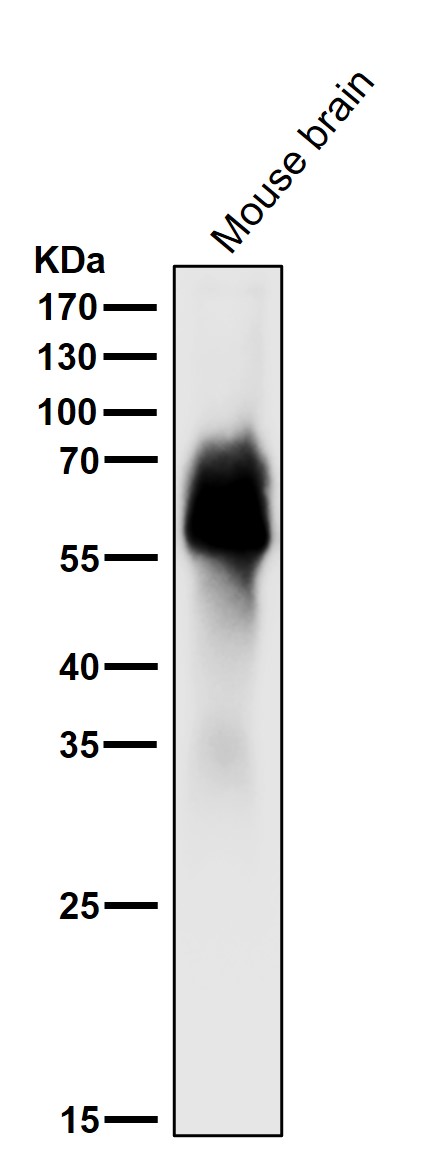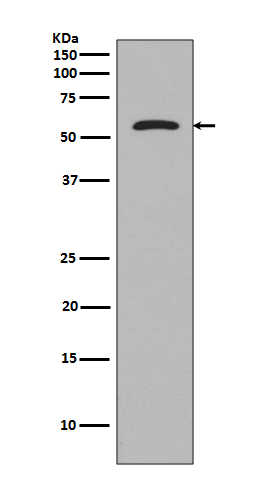

| WB | 1/1000-1/2000 | Human,Mouse,Rat |
| IF | 1/20-1/50 | Human,Mouse,Rat |
| IHC | 1/100-1/200 | Human,Mouse,Rat |
| ICC | 技术咨询 | Human,Mouse,Rat |
| FCM | 咨询技术 | Human,Mouse,Rat |
| Elisa | 咨询技术 | Human,Mouse,Rat |
| Aliases | MAPT; Microtubule-associated protein tau; MTBT1; Neurofibrillary tangle protein; Paired helical filament-tau; PHF-tau;Tau |
| WB Predicted band size | Calculated MW: 79 kDa ; Observed MW: 50-80 kDa |
| Host/Isotype | Rabbit IgG |
| Antibody Type | Primary antibody |
| Storage | Store at 4°C short term. Aliquot and store at -20°C long term. Avoid freeze/thaw cycles. |
| Species Reactivity | Human,Mouse,Rat |
| Immunogen | A synthesized peptide derived from human Tau |
| Formulation | Purified antibody in PBS with 0.05% sodium azide,0.05% BSA and 50% glycerol. |
+ +
以下是3-4条关于Tau抗体的参考文献摘要(基于公开研究,具体信息需以原文为准):
---
1. **文献名称**:*Tau-targeted immunotherapy for Alzheimer’s disease: status and future directions*
**作者**:Iqbal K, Grundke-Iqbal I
**摘要**:综述Tau蛋白在阿尔茨海默病中的病理作用,探讨不同Tau抗体(如针对磷酸化或构象表位的抗体)的研发进展,以及其在减少神经纤维缠结和改善认知功能中的潜力。
2. **文献名称**:*Anti-tau antibody administration increases plasma tau in transgenic mice*
**作者**:Sankaranarayanan S et al.
**摘要**:通过转基因小鼠模型研究抗Tau抗体(如单克隆抗体HJ8.5)的清除机制,发现抗体通过结合细胞外Tau促进其被巨噬细胞吞噬,减少脑内Tau病理并提高血浆Tau水平。
3. **文献名称**:*Tau antibody targeting pathological species in Alzheimer’s disease brain*
**作者**:Novak P et al.
**摘要**:报道一种人源化抗Tau抗体(如AADvac1)的1期临床试验结果,证明其安全性及对异常磷酸化Tau的靶向能力,提示其可能延缓阿尔茨海默病进展。
4. **文献名称**:*Phosphorylation-specific anti-tau antibodies reduce tau propagation in neuronal models*
**作者**:Dujardin S et al.
**摘要**:研究特异性靶向磷酸化Tau(如pSer396/pSer404表位)的抗体在细胞模型中抑制病理性Tau蛋白的细胞间传播,为治疗tauopathies提供机制依据。
---
建议通过PubMed或Google Scholar检索上述关键词获取原文。如需具体年份或期刊,请告知进一步调整。
Tau antibodies are essential tools in neuroscience research and diagnostics, primarily targeting the tau protein—a microtubule-associated protein critical for stabilizing neuronal microtubules in the brain. In healthy neurons, tau regulates cytoskeletal integrity and axonal transport. However, in neurodegenerative disorders like Alzheimer’s disease (AD), chronic traumatic encephalopathy (CTE), and certain forms of frontotemporal dementia, tau undergoes abnormal post-translational modifications, including hyperphosphorylation. This leads to its dissociation from microtubules, aggregation into insoluble neurofibrillary tangles (NFTs), and subsequent neuronal dysfunction and death.
Tau antibodies are designed to detect specific epitopes or pathological forms of the protein. For example, phosphorylation-specific antibodies (e.g., AT8. PHF1) recognize hyperphosphorylated tau characteristic of NFTs, while conformation-dependent antibodies (e.g., MC1) identify misfolded tau. These antibodies are widely used in techniques like immunohistochemistry, Western blotting, and ELISA to study tau pathology in postmortem brain tissues, animal models, and biofluids (e.g., cerebrospinal fluid). Recent advances aim to develop tau antibodies as diagnostic biomarkers for early disease detection or as therapeutic agents to clear toxic tau aggregates. However, challenges remain, including ensuring antibody specificity, overcoming the blood-brain barrier for therapeutics, and understanding tau's heterogeneous isoforms and strain variations across diseases. Ongoing research continues to refine their applications in both understanding tau-related neurodegeneration and translating findings into clinical interventions.
×